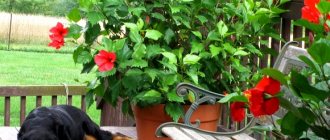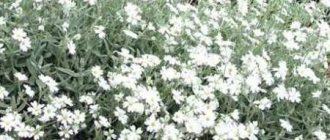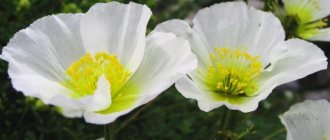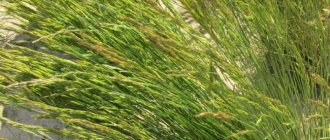Features of growing Iberis
Iberis is a subshrub that grows up to 50 cm, with a tap root system, small lanceolate leaves and small flowers collected in umbrella inflorescences. The most common petal color is white, but some species have pinkish, purple and dark red hues.
Iberis is also called variegated, wallflower or peppercorn
The plant has many varieties - among them there are herbaceous, semi-shrub, frost-resistant, heat-loving, as well as annual and perennial varieties.
For cultivation in the domestic climate, perennial varieties are most often used - they tolerate winter well and delight owners with their elegant appearance for several years in a row.
The flowering period lasts 1.5–2 months - depending on the variety, the first inflorescences can be seen in May or August. Iberis blooms thickly and luxuriantly - sometimes the leaves are completely hidden under numerous flowers, and the area is filled with an intense fragrance.
Propagation of the plant is possible both by seeds and by vegetative methods (dividing the bush, seedlings), but experienced gardeners prefer the first option. Due to the taproot system, Iberis does not tolerate transplantation well. It is much easier to collect seeds that remain viable for four years and plant them in the ground. The exception is in regions with an unstable climate, where frosts are observed in April and May - in this case, it is better to grow the flower as seedlings.
Description of Iberis: varieties and varieties
The culture is represented by both perennial and annual shrubs. Gardeners prefer to grow the following types:
- Gibraltar. Wide, up to half a meter in diameter, shrubs are decorated with evergreen narrow foliage. The small, soft pink flowers change color to white over time. Even in harsh climates, Gibraltar blooms twice per season. The bushes grow up to 20 cm; the most popular varieties of this Iberis are Candytaft and Candy Tuff. The latter has large purple inflorescences reminiscent of dahlias;
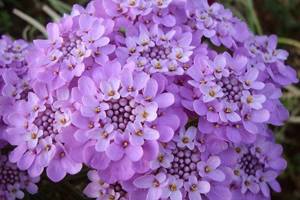
What does Iberis look like?
- Iberis evergreen has tough, leathery foliage with a bright malachite color. The spherical bushes grow up to 40 cm, white umbrella inflorescences decorate the flowerbed for a month. Ripe buds produce a lot of seed material with good germination. The shrub is unpretentious to the soil, but prefers sandy or rocky soil. Well-known varieties include Fidel, Snowfleck, Little Jam, Iberis evergreen Whiteout;
- Crimean is a dwarf perennial, not exceeding 7 cm in height, which can be planted anywhere. In winter, it needs special shelter due to poor frost tolerance. Decorated with dense green foliage resembling blades. Purple buds after final ripening become snow-white. Crimean blooms in April days;
- rocky grows up to 13 cm, the bushes are voluminous and dense. During the flowering period they resemble a spruce dusted with snow. The buds are creamy or pinkish in color and last on the bushes for a little over a month. The line of popular varieties includes Pygmaea and Hyacintenblütige Risen.
For your information! Iberis umbrella is an annual plant that grows up to 40 cm. White flowers are collected in inflorescences, flowering lasts about 3 weeks. Iberis umbellata Ice Garnet is distinguished by buds painted in white and red contrasting shades. Grows up to 40 cm in height.

Iberis umbellata
What climate is it suitable for?
In the wild, Iberis is found mainly in the mountains of southern Europe and Asia Minor, in the Caucasus, Crimea and on the banks of the Don, so the optimal climate for it is hot or temperate. It withstands frost, but reacts poorly to sudden temperature changes and lack of snow. Accordingly, it is better to cover the plantings for the winter - if the temperatures are too low and there is too much precipitation, the plant may die. Otherwise, Iberis is quite hardy, and its cultivation does not require any special conditions.

Iberis is an excellent honey plant
Photos and descriptions of popular varieties
There are about 40 varieties of Iberis in the world, but the most popular are perennial species that tolerate cold winters, frosts and other climate difficulties.
Not all types and varietal varieties of Iberis have the pleasant smell characteristic of this plant.
Evergreen
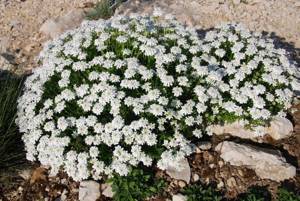
The size of a single oval leaf plate of evergreen iberis does not exceed 7 cm
A subshrub 30–40 cm high, found in the wild in the south of Asia Minor and Europe. It has dense leaves with rich colors, umbrella-shaped inflorescences and white flowers with a diameter of no more than 1.5 cm, which appear in mid-June. If you regularly remove faded inflorescences after the first flowering, the evergreen Iberis will bloom again at the end of August and will delight the eye until the first frost. Common varieties are findell, snowflake, little jam, whiteout. There is a separate variety of evergreen Iberis - bitter, its height is 20–30 cm, and the flowers sometimes have a light purple hue.
Crimean
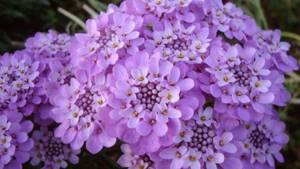
Crimean Iberis is cultivated mainly as an open ground plant, which is excellent for decorating garden plots due to the more frequent or dense growth of stems to each other
The natural habitat of the plant is the Crimean peninsula, from where the plant got its special name. A variety of flower that reaches only 5–10 cm in height, but looks very impressive - thick gray-green leaves and purple inflorescences, which acquire a white tint after the buds open. It blooms mainly in spring, prefers mild and temperate climates, and does not tolerate severe frosts quite well.
Gibraltar
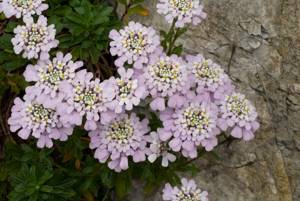
Iberis Gibraltar is suitable for landscaping rocky areas
It is considered a perennial plant, but in cold winters it blooms only 1–2 times. The bushes grow up to 25 cm, have small narrow leaves and umbrella-shaped inflorescences, which before flowering have a lilac tint, but over time their petals become almost white. The most popular variety among gardeners, which is often used for decorative purposes, is candytaft. Its large inflorescences are larger than those of other species and slightly resemble dahlia flowers.
Rocky
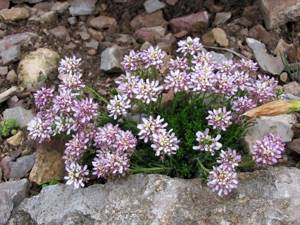
Iberis rocky is used for rockeries, borders, mixborders, in rocky areas, tolerates cutting well
In nature, this plant species is common in the rocky regions of southern Europe. Stems up to 15 cm high are covered with a large number of light pink or cream flowers already at the end of April. Flowering lasts 1–1.5 months, the most common varieties are Weiss Risen and Tom Tamb.
Umbrella
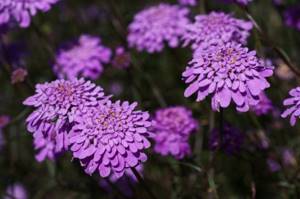
Iberis umbelliferum has the most vibrant flowers of all plant varieties.
This annual has branched stems that grow 40 cm in height. They are covered with brownish-green smooth bark and small whole leaves. In June, many dense corymbose inflorescences with snow-white fragrant flowers bloom. They bloom for more than two months. The main varieties are red rush and pink dream. Red rush is a subshrub about 30 cm high covered with carmine-red inflorescences. Pink Dream - many small bright pink flowers bloom above the low dark green shoots; this cold-resistant plant can withstand short-term frosts.
Types and varieties with photos
Iberis perennial
Crimean - (I. simplex) - size about 12 centimeters, lilac buds:
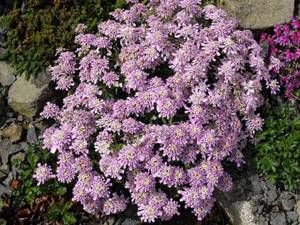
Ever-blooming (I. semperflorens) - a bush up to 50 centimeters in size, white flowers:
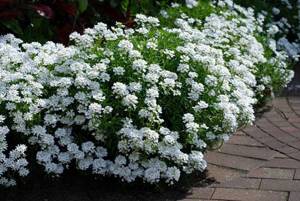
Iberis evergreen (I. sempervirens) is a subshrub up to 45 centimeters in size, some varieties are Findel, Snowflake, Little Gem:
Iberis Gibraltarica - (I. gibraltarica) - semi-evergreen bush with purple flowers, a popular variety is candytaft.
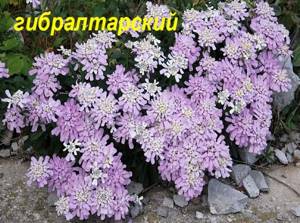
Rocky (I. saxatilis) - stems with flowers resemble powdered snowflakes.

Annuals
Variegated - a fragrant variety with variegated leaves and white flowers.
Iberis bitter (Iberis amara) - bushes up to 30 centimeters, varieties - Tom Thumb, Hyacintenblutige Risen, Weiss Risen.
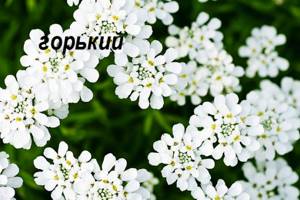
Iberis umbrella (Iberis umbellata) - size up to 40 centimeters:

Iberis in landscape design
Landscape designers use Iberian mainly for edging flower beds and creating alpine slides, but the plant is also well suited for other purposes. Its petals have a noble, pastel color palette, so they go well with other crops. Iberis looks especially impressive among evergreen dwarf trees and creeping plants. Another universal option that is suitable for any garden is a combination of small Iberis flowers with large inflorescences of marigolds, bells, and gazania.
Most species have long been cultivated by humans as ornamental plants; the plant became widespread in the 17th century in central Europe.
Photos of application options in the garden and on the site

Iberis is good in group plantings on rocky slopes, rockeries and alpine hills
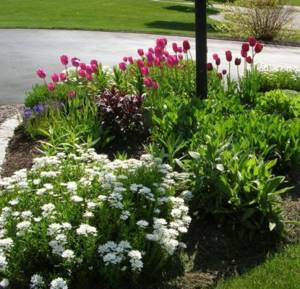
Inflorescences on tall stems, characteristic of medium-sized varieties, can be cut to make bouquets that last 7–10 days

In some countries, young shoots of Iberis are eaten; they taste sweet and resemble broccoli.
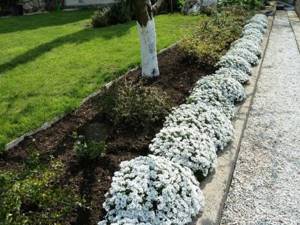
In the garden or along paths (paths), plant such a small but spectacular plant in a clearly visible place
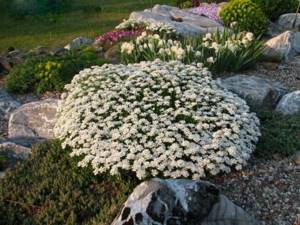
It is desirable that the soil under Iberis have a high calcium content for better growth and further development
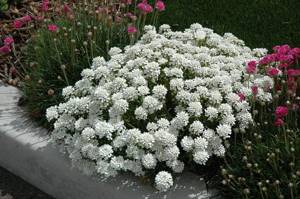
Iberis effectively decorates the garden and terraces, filling the air around with a pleasant honey aroma
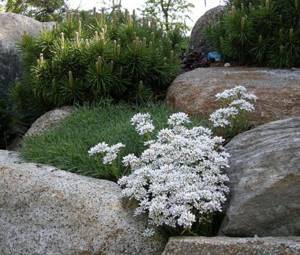
In the garden, as a rule, Iberis is planted on small elevations, for example, it could be a small rocky hill or a flower bed
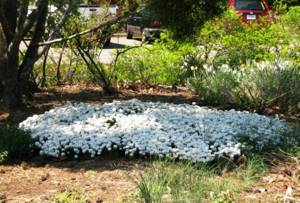
Iberis blooms so abundantly that during this period the plant is compared to clouds or snow caps
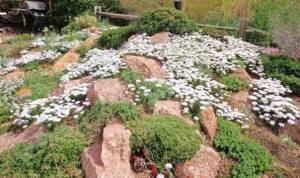
Iberis is one of the best plants for growing in large open areas
Description of the plant
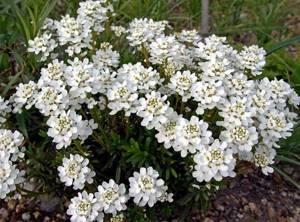
There are many varieties of Iberis, so it is unlikely to be possible to describe it in a few words. There are species with erect stems and creeping ones. The flowers of the plant are small, they are collected in umbrella-shaped inflorescences. Usually the flowering is very dense, even the leaves can be hidden behind clouds of flowers. Iberis can be of different heights. Some varieties are presented as shrubs, others are herbaceous. Wallwort flowers come in different shades. The most common is white. But there are also inflorescences with pink, lilac, cream, lilac, and purple colors.
Particular attention should be paid to the root system of the flower. It has a rod shape. Therefore, it is worth refusing to replant so as not to damage the plant.
Planting methods
Iberis can be planted with seeds or seedlings - the material for sowing is sold in gardening stores or you can collect it yourself. The best option is to grow the plant by sowing it in open ground to prevent damage to the seedlings during transplantation, but in regions with late frosts it is better to choose the second option.
Planting seeds in the ground
Iberis is planted in open ground in the second half of April, when spring frosts are behind us. The optimal air temperature is +10–15°C, but soil warming should also be taken into account. If it has not warmed up at all, it is better to wait until the end of the month to plant. To ensure constant flowering, the seeds are planted with a break of 2-3 weeks.
For planting, it is best to choose an area with loamy or rocky soil, which is well illuminated by sunlight and drains - excess moisture is extremely dangerous for the root system of Iberis and can very quickly ruin the entire planting. The sequence of actions is as follows:
- Dig holes no more than 10 cm deep at a distance of 12–15 cm from each other - this is an important condition, since Iberis can grow greatly on fertile soils.
- Distribute the seeds evenly and lightly sprinkle with soil (there is no need to plant the plant too deeply), if necessary, moisten the soil. It is better to place different varieties of Iberian weed away from each other, otherwise cross-pollination will occur.
- Wait for the first shoots and thin them out so that the distance between the bushes is 20–25 cm.
If the air temperature is 18–20°C, sprouts will appear in 7–10 days; at an air temperature of about 15°C, in 14–20 days.
Growing seedlings
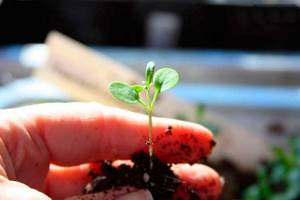
If all the conditions necessary for the normal growth of Iberis are met, the plant takes root well
The optimal time for planting Iberis seeds for seedlings is mid-March. To do this, you need to take shallow containers and a sand-peat mixture, and then perform the following steps:
- Steam the soil (if necessary) and loosen it well.
- Distribute the seeds over the surface and press slightly to a depth of no more than 1–2 mm; the top can be lightly dusted with clean river sand.
- Cover containers with seeds with glass or polyethylene, place in a warm place with good lighting, the temperature should be kept between 15–18°C.
- Crops must be periodically ventilated and moistened, but only with a spray bottle, otherwise the seeds will simply rot. The first shoots should appear in 1–4 weeks.
- After the sprouts appear, the shelter should be removed, and young plants should be hardened off from time to time - taken out into fresh air for a short time.
- Seedlings are planted in an open area after they reach a height of 7 cm - approximately in the middle or end of May. Seedlings need to be planted at a distance of 12–15 cm from each other at a sufficient depth, without shaking off the earthen lump and trying not to damage the delicate roots.
- After planting the seedlings, the soil around them should be compacted and slightly moistened.
Iberis will begin to bloom only in the second year.
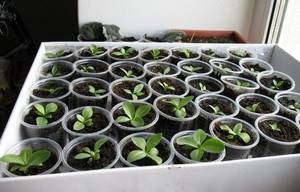
Since Iberian has a tap root system, it is not recommended to pick the plant, although some gardeners carry out a similar procedure
Video: sowing Iberis seeds
Planting and propagation
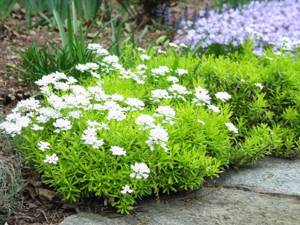
Almost all types of crops can be sown directly into the ground in April. It is quite easy to grow Iberis from seeds; any novice gardener can cope with this task. If you plan to propagate by seedlings, then the seeds are germinated in March. You can also propagate stennik by cuttings 5 cm long. The cuttings are grown in a cultivation room using phytohormones, then planted in a flower garden in the spring of next year. The most common and popular species, a favorite of flower growers and florists, Iberis umbelliferae.
How to plant Iberis
There is an annual and perennial type of crop. Basically, flower fans grow perennial species of wallflower, which grow in one place for at least 6 years. An annual plant can be planted in a new place every year. Before you start planting a plant, you need to understand how to plant Iberis and choose a site for planting. The place for the crop is sunny, the soil is sandy or loamy.
Annual Iberis is planted in open ground in May, when night frosts no longer threaten the plant. If you plant the seeds of the plant for the winter, the wallflower will bloom in early May, delighting with fragrant flowers.
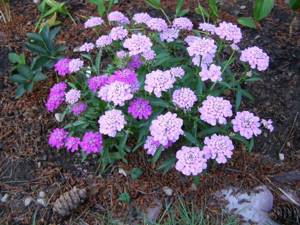
Growing Iberis from seeds
Iberis is grown from seeds, vegetatively or by cuttings. Among the annuals, Iberis umbelliferum and Iberis bitter are common and grown from seeds. You either collect the seeds yourself or buy seed mixtures in specialized flower shops, for example, Iberis gems, Iberis Snowfall. Stennik can also spread by self-sowing.
Iberis annual blooms all summer; after flowering, seeds are formed, which are collected after ripening. The seed pods are dried, then poured into containers and stored until planting. The seedling box is filled to the brim with soil, compacted, and moistened. The seeds are evenly placed in the ground. A thin layer of earth or sand is poured on top and compacted again. The box is closed with a plastic lid or film. Seedlings with the first true leaves are planted in a permanent place. In April, some types of wallflower are sown in open ground, shoots appear after seven days, the gap between shoots is 15 cm.
Cuttings
Stennik is propagated by cuttings in the summer, the apical cuttings are cut and rooted. Shoots 10 cm long are cut and rooted in soil abundantly spilled with water, and the planting is covered with plastic film. As soon as the first shoots hatch, the film is removed and the crop is planted in a permanent place. Lodging shoots send out roots, they are separated and planted in a new place.
Caring for Iberis in open ground
Iberis is one of the most unpretentious plants that do not require special care or serious expenses.
Recent Entries
5 working ways to use tar in the garden 7 indoor plants that help you get married even in adulthood Indoor plants that can bloom in trouble
Moderate watering of plantings is necessary only in intense heat and in the absence of precipitation for a long time - the rest of the time the plants will extract moisture from the lower layers of the soil.
Iberis also does not need regular feeding - it is enough to feed the plantings with complex mineral fertilizers no more than twice during the summer. This is done after the first leaves appear and at the beginning of the flowering period. Fertilizing will have a positive effect on the splendor and abundance of flowers - after fertilizing they become more spectacular. To ensure that the planting looks neat and does not grow too much, it is recommended to regularly cut off the wilted inflorescences.
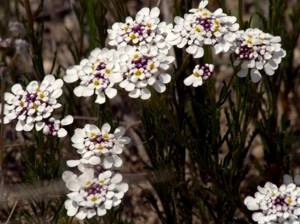
Iberis leaves are hardly noticeable due to the almost covered inflorescences
Features of care

Growing Iberis is not at all difficult, and even inexperienced gardeners can cope with it. Watering should only be done during dry periods. Such flowers can do without fertilizing, but for even more lush flowering, Iberis can be fed 1 or 2 times per season with complex fertilizer. In order for the plant to grow and develop normally, it needs to remove fading flowers in a timely manner. When the plants fade, they need to shorten the shoots by 1/3, in this case the bushes will look very neat. A perennial plant that is 5 years old needs to be replanted, otherwise the flowers will become smaller and the bush will become less spectacular.
Diseases and pests
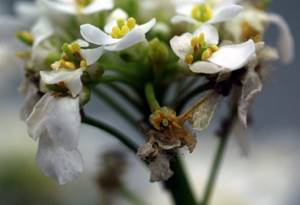
Among the pests, cabbage aphids, mealybugs and flea beetles can settle on such flowers. To ensure that the fleas that eat holes in the leaf blades go away, it is recommended to moisten the soil around the bush. To get rid of aphids, you will need to treat the infected flower with a solution of liquid potassium soap (150–200 g of the substance per half bucket of water). If necessary, it will be possible to re-process after 7 days. To get rid of mealybugs, you will need to treat the bushes with mospilan, actar or fitoverm. In this case, such treatment will need to be carried out one more time 7–15 days after the first.
The root system of such a plant is susceptible to fungal diseases. For preventive purposes, before planting such a flower, you need to water the area with a fungicidal agent. If the roots begin to rot, the infected specimens will need to be dug up and burned, and the place where they grew should be disinfected. This flower is very resistant to other diseases. If you water it according to all the rules, then Iberis will not be afraid of fungal disease.
Care after flowering
To preserve the aesthetic appearance of the plantings after flowering, it is necessary to trim the stems - at least 1/3 of them are removed. The pods that form in place of the flowers can be collected for seeds. When the plants reach the age of 5–6 years, they need to be replanted, otherwise the inflorescences will become small and sparse, as a result of which the flower bed with Iberis will lose its decorative properties.
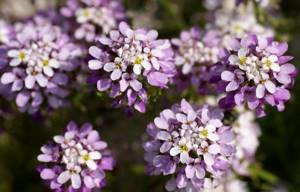
Iberis flowers are suitable for cutting; they are often used in floristry
Despite the fact that most varieties of Iberis are frost-resistant plants, in temperate and harsh climates it is better to properly prepare them for winter.
In the southern climate, in the last ten days of autumn, it is enough to add a little compost to the soil around the plantings - it is important not to overdo it, otherwise the bushes will subsequently grow too much.
If Iberis grows in regions with harsh, snowless winters, the plantings should be covered with fallen leaves, spruce branches or dry brushwood sprinkled with a small amount of hay.
Possible problems when growing a flower
As a rule, gardeners do not have problems with growing Iberis, but to do this they need to choose the right site for planting the plant. On too heavy and wet soils, Iberis is affected by fungal diseases. If other plants belonging to the cruciferous family (cabbage, radishes, etc.) previously grew on the site, there is a high probability that a pest called cabbage clubroot lives in the soil. It remains in the soil for a long time and is destructive to the root system, so before planting it is best to treat the area with a fungicidal solution.

After pollination of Iberis, small flattened pods with two valves ripen; inside there are small brown seeds.
Among the pests, Iberis are often affected by mealybugs, flea beetles and aphids.
If characteristic damage to the foliage appears, which indicates infection of the plant, it is necessary to immediately treat it with special insecticide preparations.
Diseases and pests
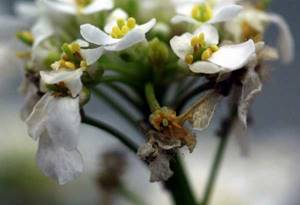
Iberis is considered a quite strong plant, with good immunity to various kinds of pests and diseases. But if the plant is weakened, it may succumb to their negative effects.
For example, fungi can attack a flower. Cabbage clubroot is caused by a fungus. It is capable of living in soil for up to 15 years. Peculiar tumors appear on the roots. They greatly retard growth or stop it altogether. It is very difficult to detect the disease when it begins. During the day, the leaves may become paler, even yellowish, and wilt. But at night they recover.
This disease cannot be cured. It is important to carry out preventive maintenance of soil and planting material using special substances. Young seedlings die from this disease. Adults can exist, but they look unhealthy and bloom inadequately.
Rhizoctoniosis most often occurs during rainy, cold weather. Gray spots with black dots appear on the stems near the roots and on the roots themselves. The plant first begins to wither and then dies. To combat this problem, fungicides are applied to the soil; acidic soils require the addition of lime. All infected copies must be destroyed.
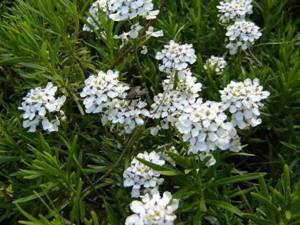
Insects also sometimes attack Iberis. For example, a sucking insect is a hairy louse (mealybug). It sucks out the juices, releasing an unpleasant, cotton-like sticky substance. This is honey dew. Sooty fungi grow on it over time.
If this happens, the plant completely loses its decorative effect and practically stops growing and developing. If the infestation is not severe, then all insects should be removed, just like honeydew. The plant is then sprayed with garlic or tobacco infusion. You can also use a soap solution. The treatment must be carried out three times. In case of severe damage, chemical agents are used. Treatment is performed 2-3 times every 1-2 weeks.
Another parasite that affects Iberis is the cabbage aphid. Colonies of insects suck out the juice, and this kills the flower. At first, the leaves are covered with light spots that turn brown. The leaves begin to curl, budding stops, as does flowering.
The plant is sprayed against cabbage aphids with special chemicals or tobacco decoction or soap solution.
The green part of the wallflower can be destroyed by the earthen flea. Its presence is indicated by large spots on the inside of the leaves. Loose lines also appear on the stems, and the plant withers. The insect jumps on the plant and in the same way lands on neighboring flowers. You can fight it with tansy decoction and insecticides. Moistening the soil near Iberis also helps.
